
John Augustus Roebling was a German-born American civil engineer. He designed and built wire rope suspension bridges, in particular the Brooklyn Bridge, which has been designated as a National Historic Landmark and a National Historic Civil Engineering Landmark.
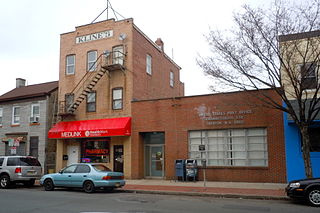
Chambersburg is a neighborhood located within the city of Trenton in Mercer County, New Jersey, United States. It is considered part of South Trenton. Chambersburg was an independent municipality from 1872 to 1888.

Mill Hill is a historic neighborhood located within the city of Trenton in Mercer County, New Jersey, United States. It is considered to be part of Downtown Trenton and was added to the National Register of Historic Places in 1977. The name Mill Hill refers to central New Jersey's first industrial site, a mill, erected in 1679, at the southeast corner of the present Broad Street crossing of the Assunpink Creek. Mill Hill and its wooden mill were among the holdings of the first settler in the vicinity of Trenton, Mahlon Stacy, a Quaker who arrived in North America in 1678. The mill was destroyed in a flood.
The New Jersey Register of Historic Places is the official list of historic resources of local, state, and national interest in the U.S. state of New Jersey. The program is administered by the New Jersey's state historic preservation office within the New Jersey Department of Environmental Protection.
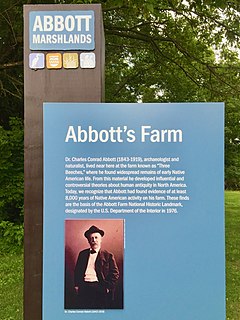
The Abbott Farm Historic District is a National Historic Landmark archaeological site in New Jersey. It is the largest known Middle Woodland village of its type on the East Coast of the United States. Significant evidence suggests that the Delaware River floodplain was occupied by Paleoindian people for a long period. It was inhabited between 500 BC and 500 AD. It has been a source of controversy and debate around early development.

List of the National Register of Historic Places listings in Mercer County, New Jersey

The Douglass House in Trenton, Mercer County, New Jersey, United States, was built in 1766. It served as George Washington's headquarters prior to the January 3, 1777 Battle of Princeton. It was listed on the National Register of Historic Places in 1970. As of 2017 the house was undergoing extensive renovation.
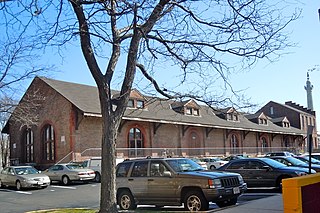
Trenton is a historic railroad station located in Trenton, Mercer County, New Jersey, United States. The station was built in 1888 by the Philadelphia and Reading Railroad. It was located on the railroad's Trenton Branch. It was added to the National Register of Historic Places on May 14, 1979, as the Philadelphia and Reading Railroad Freight Station.

Trenton City Hall is located in Trenton, Mercer County, New Jersey, United States. The white marble building was built in 1907 and added to the National Register of Historic Places on January 30, 1978. The building contains murals by American painter Everett Shinn.

Bellevue Avenue Colored School is located in Trenton, Mercer County, New Jersey, United States. The building was built in 1883 and added to the National Register of Historic Places in 1997.

The Old Eagle Tavern is a historic building located at 431, 433 South Broad Street at the corner of Ferry Street in Trenton, Mercer County, New Jersey. The building was built in 1765 by Robert Waln. The building operated as a tavern and hotel from 1765 to 1896. It was added to the National Register of Historic Places on November 3, 1972 for its architectural, commercial, and political significance. The building is also a contributing property of the Trenton Ferry Historic District, which was listed on June 26, 2013.
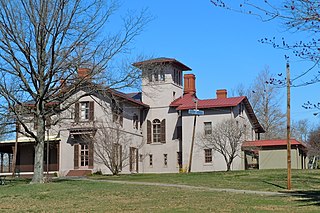
Mansion House is a historic residence located in Trenton, Mercer County, New Jersey, United States. The house was built as a summer residence for Henry McCall Sr. of Philadelphia in 1848, and is one of the earliest examples of Italianate architecture in the United States.

Gen. Philemon Dickinson House is located in Trenton, Mercer County, New Jersey, United States.

Rudolph V. Kuser Estate is located in Trenton, Mercer County, New Jersey, United States. The building was built in 1905 and was added to the National Register of Historic Places on August 24, 1979.
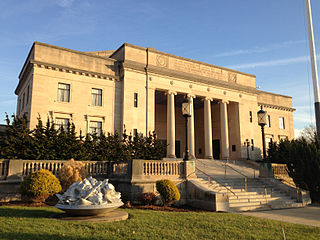
Trenton and Mercer County War Memorial-Soldiers' and Sailors' Memorial Building, known as the Trenton War Memorial, is located in Trenton, Mercer County, New Jersey, United States. The building was built in 1930 and was added to the National Register of Historic Places on December 11, 1986. It was designed by Louis S. Kaplan (1896-1964), who as a young architect won a competition to design Trenton's memorial to its Dead from World War One. Kaplan then supervised the building of the War Memorial, and after its dedication became the leading architect in Trenton until the early 1960s. Built as a concert hall, it fell into disrepair before being restored by the State of New Jersey in the 1990s. It was rededicated in 1999. The 1,807-seat theater at the War Memorial was renamed the Patriots Theater in 2001.

The Isaac Watson House is the headquarters of the New Jersey State Society of the National Society of the Daughters of the American Revolution (DAR). It is located just outside the state capital of Trenton in Hamilton Township, Mercer County, New Jersey. It is situated on a bluff overlooking Watson's Creek and the Abbott Farm National Historic Landmark in John A. Roebling Park, a 257-acre nature preserve.

The Clarkson S. Fisher Federal Building and United States Courthouse, originally known as the United States Courthouse and Federal Building, is located in Trenton, Mercer County, New Jersey, United States. and houses the United States District Court for the District of New Jersey.
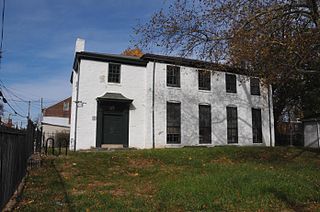
The East Trenton Public Library, in Trenton, New Jersey, was built as the Samuel Dickinson house, c. 1796 at the center of a large farm. In 1926 it became a public library, in which capacity it continues to serve.

The John Abbott II House was built ca. 1730 in what is now Hamilton Township, Mercer County, New Jersey. During the American Revolution, Samuel Tucker, the state treasurer, fleeing the British advance on Trenton, removed the money in his care to the home of John Abbott II. The location of the funds was betrayed by Mrs. Mary Pointing, who led a 500-strong detachment of British troops to the house. In ransacking the home, the soldiers discovered Tucker's trunk with his personal effects and £1500 in unsigned paper money. However, the specie money was hidden by the family in the bottom of tubs in the cellar, covered with broken dishes and household utensils. The tubs escaped close inspection and the money was kept from British hands. The house is currently home to the Hamilton Township Historical Society and is open to the public.
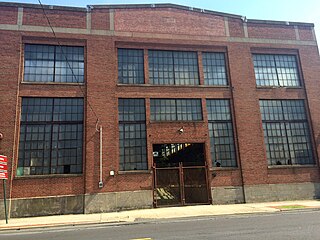
John A. Roebling's Sons Company, Trenton N.J., Block 3 is the northern portion of the former Roebling manufacturing complex in Trenton, New Jersey. The buildings date from 1908–1929 and the site was added to the National Register of Historic Places on August 22, 2012.






















